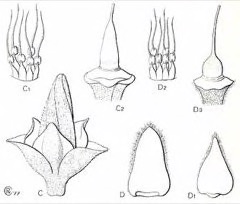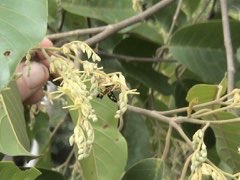 |
|
http://www.edibleplants.org |
 |
| Sepilok2007 wikimedia.org |
Translate this page:
Summary
Shorea johorensis is a large tree about 65m tall with a hemispherical crown and straight, cylindrical, buttressed bole that can be up to 160 cm in diameter. It can be found in Southeast Asia particularly in Malaysia, Brunei, and Indonesia. There are no known edible and medicinal uses of this plant but it is a source of dammar resin, a hard resin, which can be used for caulking boats and baskets, as an adhesive, fuel for torches, etc. Shorea johorensis is more valued as timber. Its wood is light, soft, moderately durable, resistant to dry wood borers and fungi but susceptible to termites. It works well with tools and fairly finishes well. It is used for panelling, joinery, light carpentry, boxes and crates, veneer, and many other purposes.
Physical Characteristics

 Shorea johorensis is an evergreen Tree growing to 50 m (164ft) by 30 m (98ft) at a medium rate.
Shorea johorensis is an evergreen Tree growing to 50 m (164ft) by 30 m (98ft) at a medium rate.
See above for USDA hardiness. It is hardy to UK zone 10.
Suitable for: light (sandy), medium (loamy) and heavy (clay) soils and prefers well-drained soil. Suitable pH: mildly acid, neutral and basic (mildly alkaline) soils. It cannot grow in the shade. It prefers moist soil.
UK Hardiness Map
US Hardiness Map
Synonyms
Shorea leptoclados Symington
Plant Habitats
Edible Uses
References More on Edible Uses
Medicinal Uses
Plants For A Future can not take any responsibility for any adverse effects from the use of plants. Always seek advice from a professional before using a plant medicinally.
None known
References More on Medicinal Uses
The Bookshop: Edible Plant Books
Our Latest books on Perennial Plants For Food Forests and Permaculture Gardens in paperback or digital formats.

Edible Tropical Plants
Food Forest Plants for Hotter Conditions: 250+ Plants For Tropical Food Forests & Permaculture Gardens.
More

Edible Temperate Plants
Plants for Your Food Forest: 500 Plants for Temperate Food Forests & Permaculture Gardens.
More

More Books
PFAF have eight books available in paperback and digital formats. Browse the shop for more information.
Shop Now
Other Uses
Adhesive Ink Lighting Paint Resin Soap making Varnish Waterproofing Wood
Other Uses: The trunk contains a dammar resin[653 ]. Dammar is a hard resin, obtained from various trees of Southeast Asia. Traditionally, it is used for purposes such as caulking boats and baskets, as an adhesive, a medicine, as a fuel for torches and sometimes in foods. Dammar has many commercial applications, though many of these uses are less important nowadays due to the advent of synthetic materials. Commercially, it is an ingredient of inks, lacquers, oil paints, varnishes etc, and is used as a glazing agent in foods[891 ]. Harvesting of the resin commences when the bole is around 25cm in diameter (approx 20 years old). Triangular cuts (becoming circular with age) are arranged in vertical rows around the trunk. The cuts are several centimetres wide at first, but become enlarged at every tapping and eventually become holes of 15 - 20cm in depth and width. The average number of holes for a tree about 30 metres tall and 60 - 80cm in diameter is 9 - 11 in each of 4 - 5 vertical rows. For the higher holes, the tapper climbs the tree supported by a rattan belt and using the lower holes as footholds. The exuded resin is allowed to dry on the tree before it is collected. The frequency with which the tree is visited to refreshen the cut varies from once a week to once a month, depending on how far the tree is from the village. Tapping can continue for 30 years[891 ]. The wood is used[653 ]. The wood is a source of a high-grade light red meranti timber[338 ] We do not have a specific description, but the general description of light red meranti is as follows:- The heartwood is light red to pink or pink-brown, with white resin streaks; it is clearly demarcated from the 5 - 8cm wide band of sapwood. The texture is medium; the grain interlocked with a ribbon-like aspect; the surface is lustrous. The wood is light in weight, soft, moderately durable, being resistant to dry wood borers, somewhat resistant to fungi and susceptible to termites. The wood seasons well with a slight risk of checking or distortion; once dry it is stable to moderately stable in service. The wood works well with normal tools, though the tools need to be kept sharp because it has a tendency towards woolliness; it generally finishes fairly well, though filling is recommended; screwing and nailing are good; gluing is correct. The wood is used for several purposes including interior and exterior panelling and joinery, light carpentry, boxes and crates, veneer etc[848 ].
Special Uses
References More on Other Uses
Cultivation details
Usually found in the wild on riversides with clayey to sandy soils[653 ]. Prefers a well-drained soil[338 ].
References Carbon Farming Information and Carbon Sequestration Information
Temperature Converter
Type a value in the Celsius field to convert the value to Fahrenheit:
Fahrenheit:
The PFAF Bookshop
Plants For A Future have a number of books available in paperback and digital form. Book titles include Edible Plants, Edible Perennials, Edible Trees,Edible Shrubs, Woodland Gardening, and Temperate Food Forest Plants. Our new book is Food Forest Plants For Hotter Conditions (Tropical and Sub-Tropical).
Shop Now
Plant Propagation
We have no specific information for this species - the information below is a general guide for the genus. Seed - best sown as soon as possible. It does not require pre-treatment, but it is recommended to soak the seed for 12 hours prior to sowing[325 ]. The seeds are sown in seedbeds, where they are covered with a mixture of sand and soil (1:1) or with a thin layer of sawdust[325 ]. Germination of fresh seeds is usually good and rapid. About two weeks after germination, when the seedlings are 5 - 6cm tall, they are potted up into individual containers about 15 x 23cm with good drainage holes at their base[325 ]. It is normally recommended to use a mixture of forest soil and sand (at a ratio of 3:1) as the potting medium in order to introduce the appropriate mycorrhiza to the roots. The seedlings are placed in 50 - 60% sunlight and watered twice daily[325 ]. Seedlings can be planted out when 30 - 40cm tall - harden the seedlings off in full sunlight for one month prior to planting[325 ].
Other Names
If available other names are mentioned here
Native Range
TROPICAL ASIA: Brunei Darussalam, Indonesia, Malaysia
Weed Potential
Right plant wrong place. We are currently updating this section.
Please note that a plant may be invasive in one area but may not in your area so it's worth checking.
Conservation Status
IUCN Red List of Threatened Plants Status : Status: Critically Endangered A1cd

Growth: S = slow M = medium F = fast. Soil: L = light (sandy) M = medium H = heavy (clay). pH: A = acid N = neutral B = basic (alkaline). Shade: F = full shade S = semi-shade N = no shade. Moisture: D = dry M = Moist We = wet Wa = water.
Now available:
Food Forest Plants for Mediterranean Conditions
350+ Perennial Plants For Mediterranean and Drier Food Forests and Permaculture Gardens.
[Paperback and eBook]
This is the third in Plants For A Future's series of plant guides for food forests tailored to
specific climate zones. Following volumes on temperate and tropical ecosystems, this book focuses
on species suited to Mediterranean conditions—regions with hot, dry summers and cool, wet winters,
often facing the added challenge of climate change.
Read More
Expert comment
Author
Foxw.
Botanical References
Links / References
For a list of references used on this page please go here
A special thanks to Ken Fern for some of the information used on this page.
Readers comment
| Add a comment |
|
If you have important information about this plant that may help other users please add a comment or link below. Only comments or links that are felt to be directly relevant to a plant will be included. If you think a comment/link or information contained on this page is inaccurate or misleading we would welcome your feedback at [email protected]. If you have questions about a plant please use the Forum on this website as we do not have the resources to answer questions ourselves.
* Please note: the comments by website users are not necessarily those held by PFAF and may give misleading or inaccurate information.
To leave a comment please Register or login here All comments need to be approved so will not appear immediately.
|
Subject : Shorea johorensis
|
|
|
|